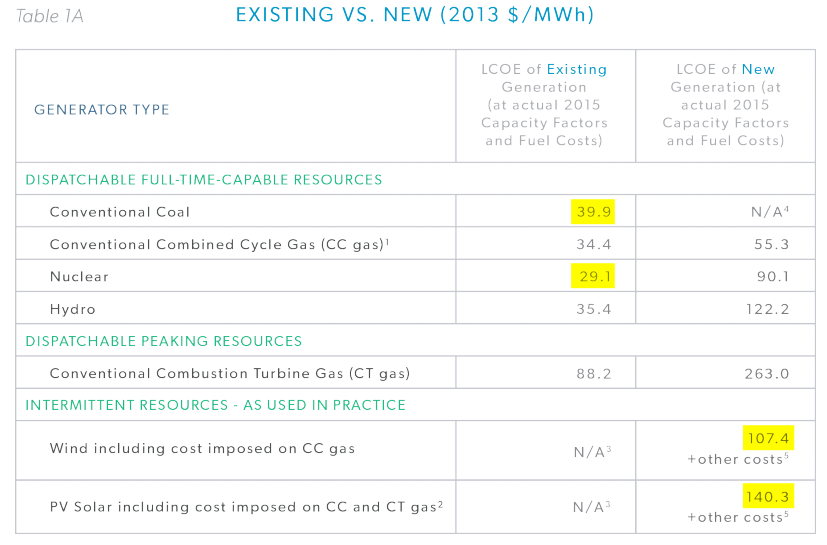Recently we released an update to our groundbreaking study by Tom Stacy and Dr. George Taylor showing how the cost of electricity from new sources compares to the cost of electricity from existing sources of generation. This is a critical comparison because America is adding a lot of new wind and solar electricity generation and closing coal and nuclear power plants.
The biggest takeaway from the study is that electricity from new wind and solar facilities is 2.5 to nearly 5 times more expensive than electricity from most existing coal and nuclear power plants.
Predictably, the wind and solar industries are not pleased by the fact that we make this comparison public. But instead of leveling with the American people and admitting that wind and solar are expensive sources of electricity, they make incorrect statements about the study. In fact, it’s obvious from their statements that they haven’t even read the study.
For example, Michael Goggin from the American Wind Energy Association (AWEA) claimed he had comprehensively rebutted the study. This is of course false. We thoroughly debunked Goggin’s claims here. Goggin did not rebut our debunking because he cannot debunk it. His arguments are not supported by reality.
The Solar Energy Industry Association’s (SEIA) claims are answered by the study itself (see p. 31-32) making it obvious that they have not read the study. Here’s their argument from ClimateWire:
Dan Whitten, a spokesman for the Solar Energy Industries Association, called the study “a textbook apples-to-oranges comparison” based on the premise that the country’s current fleet of power plants, many of which have already exceeded their life expectancies, can operate for decades longer.
“Their entire argument is built upon the false assumption that existing, depreciated power plants will continue to be inexpensive to operate and will not need to be replaced,” Whitten said in an email. “Used cars are also cheaper than new cars until they break entirely or become unreasonably expensive to repair and maintain,” he added by way of analogy.
First, our study is indeed apples-to-apples comparison. The study compares the cost of electricity from our current sources of generation to what some people would like to replace our current sources with. For example, when PG&E announced they were closing the Diablo Canyon nuclear power plant, they said they would replace the electricity with “renewables and energy storage.” The real apples-to-apples comparison, in the case of Diablo Canyon is the cost of electricity from nuclear power to the cost of electricity from new wind and solar plus the cost of building and/or underutilizing additional dependable capacity wind and solar lack.
Second, SEIA has obviously not read our report because the report specifically deals with the issue of the costs of using coal and nuclear power plants for decades. Here are two charts that show the costs (with data from the Federal Energy Regulatory Commission) of operating nuclear and coal power plants for decades.
Our study contains real data on the cost of operating nuclear power plants for the last 40 years and the cost of operating coal plants for 60 years. Yes, the cost of operating these plants increases over time, but that consideration was specifically included in our analysis. SEIA falsely claims otherwise.
One important thing to note about coal-fired power plants, for example, is that the various pieces of the plant can all be replaced as they wear out. With wind turbines, after years of use, the towers and blades become stressed and the entire structure must be replaced. This is not the case with coal-fired power plants.
Later in the ClimateWire article, the SEIA spokesman unwittingly bolstered IER’s study when he made the following analogy, “Used cars are also cheaper than new cars until they break entirely or become unreasonably expensive to repair and maintain.”
He’s correct that used cars are cheaper than new cars until it no longer makes sense to repair or maintain them, but that analogy is irrelevant in this case. Much of our nation’s coal fleets could continue to operate for decades if not for government forces such as the EPA’s carbon dioxide regulations for existing power plants. Taking it back to the car analogy, this would be akin to the EPA mandating that people get rid of their 2009 vehicles and replace them with brand new models that are more expensive, less reliable, and have a much shorter lifespan[i].
Even if we take the SEIA spokesman’s comments at face value, solar power is the most expensive choice for replacing existing plants. On an apples-to-apples basis, the average cost of electricity from new solar is 1.5 times as expensive as electricity from new nuclear plants and 2.5 times as expensive as electricity from new natural gas plants.
Conclusion
Our report on the levelized cost of electricity from existing generation resources has now been out for more than a year and we recently released an update to include solar power. The wind and solar industries have failed to demonstrate anything wrong with the report and instead they resort to false claims and hand-waving instead of squaring with the American people and admitting that electricity from wind and solar facilities is of very high cost and very low value compared to the sources of electricity generation we are currently using—and can continue to use for decades into the future.
[i] EIA makes no distinction between the 20-25 year expected lifespans of win and solar facilities vs. the 50+ year lifespans of most other technologies. See the following publications: http://www.nrel.gov/docs/fy11osti/47078.pdf , http://eelegal.org/?page_id=1734
